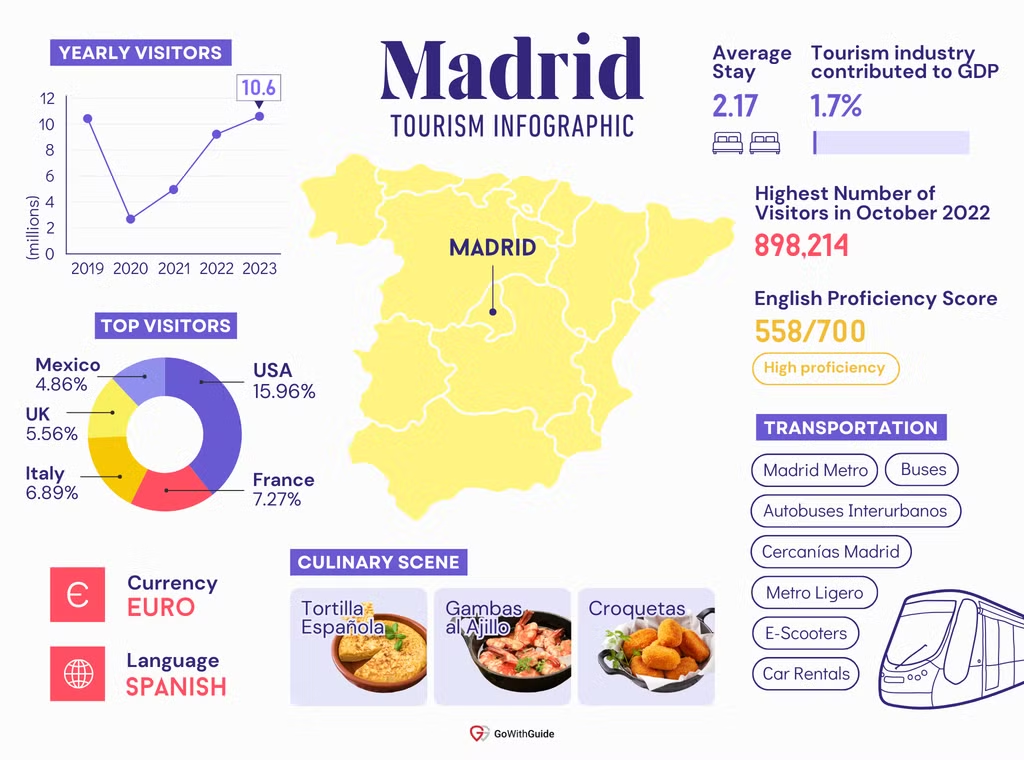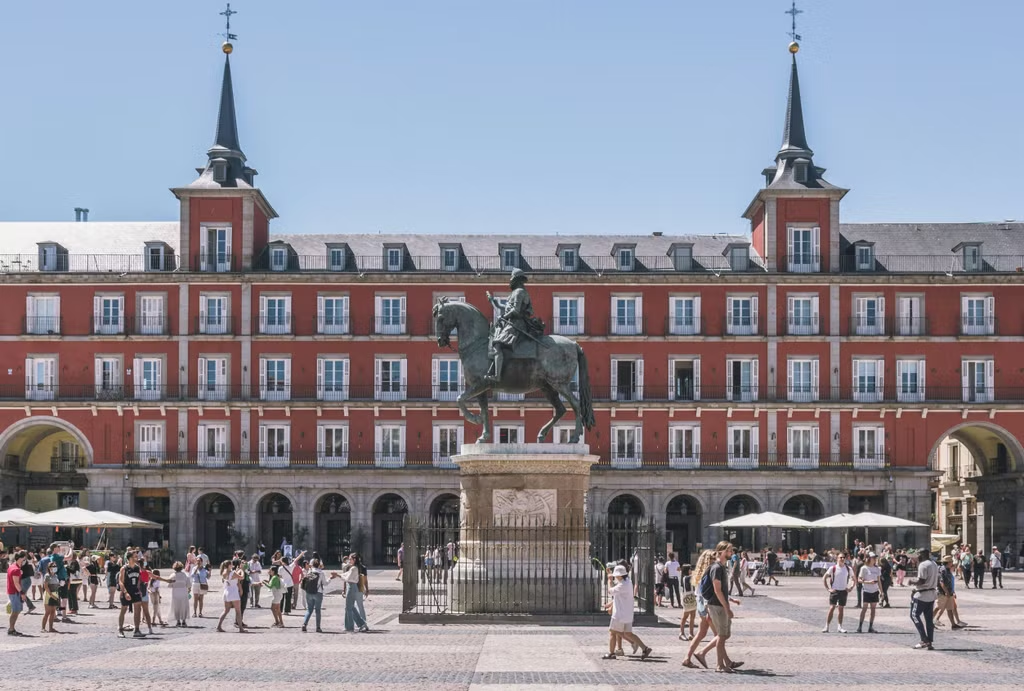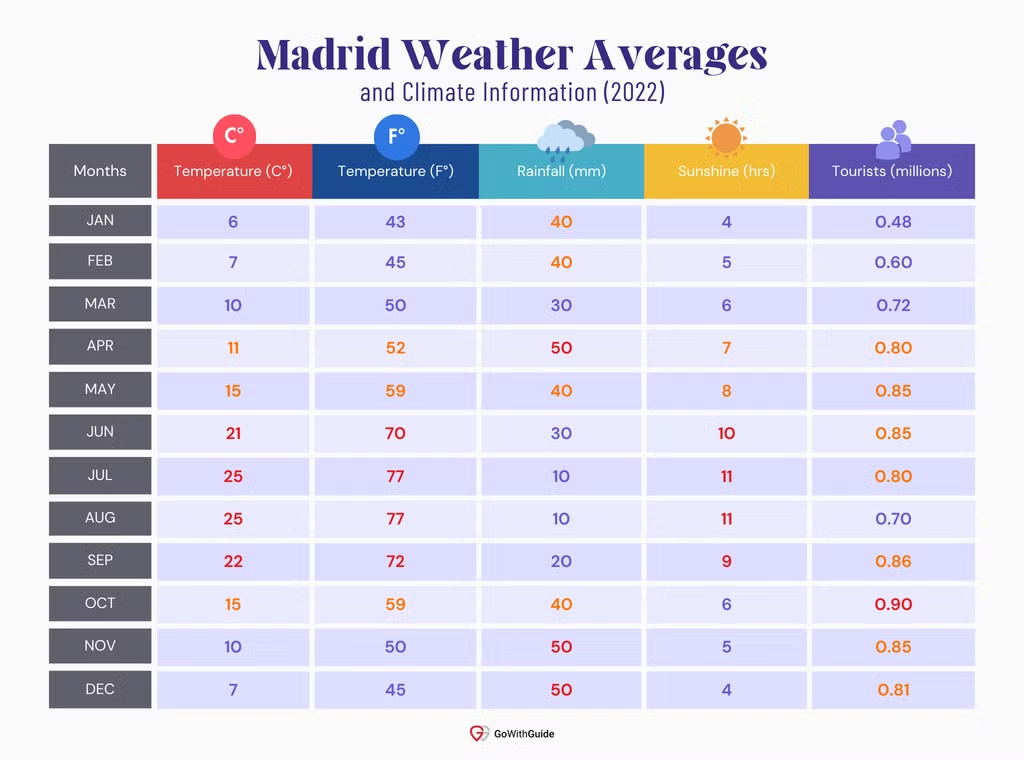Feel the warmth of the Spanish sun on your skin as you stroll past centuries-old architecture adorned with intricate designs. Listen to the lively chatter of locals enjoying a leisurely afternoon café con leche, and smell the tempting aroma of sizzling tapas surrounding you.
This is Madrid, and it’s just beckoning for you to visit.
Before traveling to a new country or city, whether you’re going solo, or teaming up with a Madrid tour guide, it’s essential to learn about the ins and outs of why people visit, and what you can expect when you land. This is where this article comes in. So let’s learn about tourism in Madrid!
Tourism Statistics In Madrid: Analyzing Visitor Trends & Patterns
The capital of Spain is such a fantastic city to explore, but how many tourists visit Madrid each year? For the last five years, the city has seen fluctuations, as you can see below, but tourists numbers are once again reaching pre-pandemic levels.

But who are these tourists? Who visits Madrid the most? Interestingly, the nationality for top tourists has been pretty consistent over the past few years, with the United States leading the pack in 2022.
-
United States (15.96%)
-
France (7.27%)
-
Italy (6.89%)
-
United Kingdom (5.56%)
-
Mexico (4.86%)
So, yes, there are many tourists in Madrid. In fact, when you look at Madrid’s tourists by month, the city is generally busy with international tourists in September and October, as well as between May and July. The low tourist period is between January and March, with another dip in August, so if you’re trying to avoid large crowds and higher rates, this is the best time to see the city of the Bear and the Strawberry Tree.
Travel Q&A: Is Madrid cheap or expensive? Well, the average daily expenditure in 2019 was €272, compared to €276 in 2022, so you can use those figures to plan accordingly.
So outside of tourists, is Madrid a busy city? Yes. Madrid has a population of 3.3m. Here's a quick overview of the city's tourism highlights.

Madrid Tourism Quick Stats
-
10.6 million - The amount of tourists that visited Madrid in 2023.
-
898,214 - The number of international and domestic tourists that visited Madrid in October 2022, the highest number of the year.
-
2.17 - The average length of overnight stays for tourists in Madrid.
-
1.7% - The amount that the tourism industry contributed to Madrid’s GDP in 2022.
The Future Of Tourism In Madrid
Madrid’s tourism looks promising as the city bounced back from the challenges of recent years. Comparing 2019 to 2022, data reveals a significant recovery in tourism. In 2022, Madrid saw a return to 2019 levels, seen by statistics such as the average length of stay, which stood at 2.17 nights, mirroring pre-pandemic figures exactly.
This resurgence is further highlighted by the economic impact of tourism. In 2019, the tourism sector contributed over 18 billion euros to Madrid's economy. Remarkably, by 2023, this figure had surged to 21.4 billion euros, highlighting the sector's vital role in driving economic growth and prosperity for the city.
Fascinating, right? But why are all these tourists visiting Madrid? Let’s find out!
Dynamic Attractions: A Magnet For Tourism In Madrid
Whether it be a two-day or week-long trip, there are some truly stunning places to visit in Madrid. From historical neighborhoods and museums, to shopping and food locations, to grand buildings, we’ve got you covered.
Madrid’s Landmarks: Stunning Buildings & Spaces

-
Puerta del Sol: Bursting with life, this square is a must-visit in Madrid. Be sure to admire the iconic ‘Bear and the Strawberry Tree’ statue and taste delicious treats from La Mallorquina.
-
Plaza Mayor: Celebrating its 400th anniversary in 2018, the Plaza’s historical significance can be felt as you walk along its towering arches.
-
Calle Mayor: Wander down Calle Mayor to encounter the picturesque Plaza de la Villa and the awe-inspiring complex of the Almudena Cathedral, Royal Palace, Teatro Real and Plaza de Oriente — the epitome of grandeur in Madrid!
-
Plaza de España: Marvel at the statues of Don Quixote and Sancho Panza, soak in the sunset views at the Templo de Debod — the only Egyptian temple in Spain — and capture stunning photos at this iconic square.
-
Gran Vía: A great place to see Madrid's bustling atmosphere, with this avenue lined with shops, theaters and cinemas. Snap a photo of the Edificio Metrópolis under the iconic Schweppes sign and explore the immersive art experience at Museo Gran Vía 15.
Cultural Marvels: Madrid's Museums & Galleries
-
Las Letras Neighborhood: Here, you can explore the literary history of Madrid's Golden Age, with highlights including the tomb of Cervantes and the Lope de Vega Museum-House. Wander through charming streets filled with old bookshops, theaters and tapas bars, offering a taste of traditional Madrid cuisine.
-
Gallery of Royal Collections: This museum space showcases treasures previously stored in National Heritage warehouses and Royal Sites. Admire unseen works and marvel at pieces typically found in palaces and monasteries.
-
Paseo del Arte/Paseo del Prado: Also known as the golden triangle, this two-kilometer stretch is home to world-renowned museums including the Reina Sofía National Art Museum, Thyssen-Bornemisza Museum and the Prado Museum, which house some of history's most significant works.
Green Spaces: Relaxation & Recreation In Madrid's Parks
-
El Retiro Park: Madrid's most famous park offers a tranquil escape, having the benefit of being near the Royal Botanical Gardens.
-
El Capricho Park: Explore one of the city's most beautiful parks, featuring an artificial river, lakes, woods, gardens, and hidden corners waiting to be discovered.
So, is Madrid a touristic city? Most definitely, as shown above, in 2023, over 10 million visitors came to Madrid to explore all it has to offer. If these stunning landmarks aren’t enough to convince you to travel to Spain’s capital city, let’s go over more specifics about why Madrid is so popular with tourists.
Beyond sightseeing, here are some uniquely Madrid experience you have to try.
Vibrant Nightlife: The Pulse Of Madrid After Dark
-
Malasaña & Chueca: These adjacent neighborhoods epitomize cool with a mix of eclectic bars, live music spots and vibrant clubs that pulse until dawn. Malasaña exudes a hip, indie vibe, while Chueca has an inclusive and lively LGBTQ+ scene.
-
Huertas & Santa Ana: History meets cocktails in the bars and taverns around Plaza Santa Ana and the Huertas neighborhood, providing a charming prelude to the city's nightlife.
-
Casa Patas & Corral de la Morería: Here you can experience authentic performances brimming with the intensity and passion of flamenco. Opera enthusiasts can revel in the grandeur of Teatro Real, one of Europe's premier opera houses, while theaters like Teatro Español showcase Madrid's rich theatrical tradition with classic and contemporary plays.
-
Teledisko: Welcome to the world's smallest nightclub! Dance solo or with friends — just pick your song and hit the floor, all for free.
Shopping Paradise: Retail Therapy in the Spanish Capital
Other than the Gran Via, which is full of international brands and flagship stores, Calle Fuencarral is also a great spot known for trendy boutiques and independent designers. If those aren’t your thing, here are some more great locations to add to your itinerary!
-
Vallehermoso Market: A prime example of market reinvention, offering diverse international cuisine.
-
El Rastro: Every Sunday, the Ribera de Curtidores becomes a bustling hub of antiques, crafts, clothing and more. While steeped in a rich 500-year history, beware of pickpockets amidst the crowds.
-
San Miguel Market: Indulge in gourmet delights at this restored historical market, showcasing a variety of gourmet products amidst Madrid's vibrant culinary scene.
Festive Events
Another reason why so many venture to Madrid is to experience the vibrant festival scene. From music festivals to cultural celebrations, the city offers a wide range of events for everyone to enjoy. Whether you're into music, food, art or simply soaking up the lively atmosphere, Madrid's festivals showcase the rich culture and spirit of the Spanish capital.
Here are just some of the things the city has to offer:
-
Virgen de La Paloma: An annual, vibrant festival in Madrid's La Latina neighborhood, celebrating the appearance of Virgin Mary in Spain. The festival features a massive block party with games, rides, food, live entertainment and religious events. Held on August 15, it is just a 15-minute walk from the city center.
-
Mad Cool: A four-day annual music festival in Valdebebas, north of Madrid, showcasing emerging and big-name pop, indie and rock acts. Attendance reaches 60,000 people daily, with performances across various genres from folk to hip hop.
-
Noche en Blanco: An annual 24-hour festival celebrating literature, art, cinema and more throughout Madrid. Businesses stay open, public squares host events and live music, while culture centers and museums remain accessible all night.
-
Carnival: Madrid's family-friendly Carnival Festival from February 10th-14th offers wild costumes, parades, masquerade balls and events for children. Includes the Masquerade Ball, Carnival Parade, and symbolic burial of the sardine.
-
Madrid Gastrofestival: From May 16th-29th, a culinary celebration across the city takes place, with over 550 activities in restaurants, bars, museums, and cultural spaces. Themed days include Gastroculture, Gastrofashion and Gastrohealth, with some events free and family-friendly.
Speaking of food, let’s go over what to eat when in Madrid!
Gastronomic Delights: Exploring Madrid's Culinary Scene
Now that you know where to go and have added these spots to your itinerary, it’s time to explore Madrid's vibrant culinary scene!
You’re truly in for a treat. From lively tapas bars to cozy cafés, the city has a diverse array of flavors and traditions to dig into, such as iconic dishes like Tortilla Española and Gambas al Ajillo. Whether you're in the mood for hearty stews or sweet churros with chocolate, Madrid has something to satisfy every craving.
Be sure to try these dishes when exploring Madrid, plus anything else that catches your eye while there!
-
Tortilla Española: A quintessential Spanish omelet made of potatoes, eggs and sometimes onions, enjoyed throughout the day, often paired with a local lager beer.
-
Gambas al Ajillo: Garlic shrimp cooked in olive oil with garlic, parsley and chili, served in a clay dish, best enjoyed with bread as a sharing plate.
-
Croquetas: Deep-fried croquettes with various fillings like ham, mushroom or cod, served as shared plates or individually, with the homemade ones being preferred.
-
Huevos Rotos: Crispy fried potatoes topped with fried eggs and optional additions like ham or chorizo, meant for sharing and mixing together.
-
Bocadillo de Calamares: A simple sandwich of fried calamari rings in a baguette, often enjoyed with beer or any cold drink.
-
Cocido: A hearty stew featuring various meats, chickpeas and vegetables, traditionally served in three courses and perfect for colder months.
-
Callos a la Madrileña: Beef tripe stew with chorizo and blood sausage, typically served in a clay dish, popular during winter with added paprika for flavor.
-
Churros: Fried dough dipped in thick hot chocolate, enjoyed as a breakfast treat or afternoon snack, often paired with coffee.
Weather All Year Round: When To Visit Madrid

Madrid's weather combines continental and Mediterranean influences, with an average annual temperature of 14ºC and extremes ranging from 5ºC to 25ºC. Despite this average, Madrid's high altitude of 2,188 feet affects its climate, meaning it has cool nights.
The city experiences dramatic temperature shifts due to its altitude and proximity to mountain ranges, meaning it has distinct seasons. There's no moderate weather period, though; it's either sunny or shaded.
So what is the main tourist time in Madrid? In 2023, Madrid’s busiest month was September, with 765,040 tourists in the region. In 2022, October was the busiest month for international travelers, followed by September, July, June and May.
Summer in Madrid
Madrid's summer can be scorching, ranking it as the fourth-hottest city in Europe. As mentioned, though, its elevated position and low humidity offer relief, with cool evenings. Daily highs often exceed 40°C, leading to midday siestas and late-night activities. Despite the heat, Madrid is Europe's least humid city, making the extremes more tolerable. June's balmy evenings are perfect for enjoying the city's vibrant nightlife. If braving the heat, June offers milder temperatures compared to July and August, with fewer rainy days.

Winter in Madrid
Even in winter, Madrid enjoys blue skies and crisp days, attracting locals rather than tourists. With continental influences, freezing temperatures are common, though snowfall in the city itself is rare. Surrounding mountains offer ample snow for winter getaways and skiing. December and January see average lows of 2°C and highs of 9°C, with January offering more sunlight than northern European cities. Madrid's sunny winter days make it an attractive destination for those looking for mild winter weather.
Transportation Handled: Accesibility & Connectivity In Madrid
Madrid's public transport system is fantastic: fast, safe, clean, and reliable. Compared to other European cities, it's cheap and efficient. It includes the Metro, day and night buses, light rail and suburban trains (Cercanías), connecting the city seamlessly.
Tourist Ticket/Tourist Travel Pass
The Tourist Ticket, usable on all public transport in Madrid, offers unlimited trips within chosen timeframes. Zone A covers the city center, including Metro, buses and trains, while Zone T includes the entire Metro network and extends to surrounding areas. Passes come preloaded on a smart card and can be purchased at various locations. Top-ups are available at stations and authorized retailers.
Let’s go over the modes of transportation in Madrid:
-
Madrid Metro: With 12 lines and 300+ stations, Madrid's metro is highly accessible, even reaching harder-to-reach places.
-
Buses: Madrid's EMT operates over 200 lines and 2,000 buses, covering areas the metro doesn't. They operate within the central zone of Madrid.
-
Metro Ligero: Madrid's above-ground light rail system connects suburban areas, spanning 4 lines and 50+ stations.
-
Cercanías Madrid: This above-ground train system spans the entire Madrid region, with 9 lines and 90+ stations, offering connections to small towns.
-
Autobuses Interurbanos: Suburban buses, run by private companies, operate over 300 lines and connect Madrid to its outskirts.
-
Renting e-Scooters, e-Bikes & Motor Scooters: Electric transportation options, including e-scooters, e-bikes, and motor scooters, are available for rent via various apps, providing eco-friendly travel.
-
Car Rentals, Carsharing & Ridesharing: For those preferring private transport, car rentals, carsharing and ridesharing services are available, offering flexible options for travel within and beyond Madrid.
-
Walking: Madrid's streets are incredibly walkable, from the historic center with landmarks like the Royal Palace and Plaza Mayor, to Gran Via's blend of old and new. Walking allows you to truly experience Madrid's rich history, art and vibrant atmosphere.
What To Know In Madrid: Safety & Dos & Don'ts
Traveling is such an amazing adventure, but it’s always important to know some unspoken rules before you arrive to ensure your trip is as seamless and enjoyable as possible. Here are some points to keep in mind:
Dos:
-
Adjust Your Meal Times: Spaniards dine later, with many restaurants opening for lunch at 1pm and closing between 6-8pm before reopening for dinner. Shifting your meal times allows you to enjoy Madrid's lively dining scene and blend in with locals.
-
Dress Appropriately: Avoid wearing shorts in March and opt for season-appropriate attire. Spaniards dress to the season and prioritize fashion and comfort, so save shorts for warmer months and wear supportive footwear for exploring the city. Also, avoid wearing flip-flops when touring the city. Save it for the beach.
-
Embrace The Siesta: Take a midday nap to escape the heat, as many businesses observe siesta time by closing during the hottest hours. Use this time to relax and recharge like the locals.
-
Drink The Tap Water: Madrid's tap water is safe to drink, so carry a refillable bottle to save money and reduce plastic waste.
Don'ts:
-
Dining In Plaza Mayor: While the square is a popular tourist spot, its restaurants often serve overpriced and mid-tier food. Enjoy a coffee in the square, but dine elsewhere for better culinary experiences.
-
Relying Solely On English: Brush up on Spanish before your trip, as not all locals speak English fluently. Learning a few phrases will make navigating the city easier and enhance your experience.
-
Carrying Valuable Documents Around: Leave your passport in your hotel safe to avoid potential pickpocketing incidents. While Madrid is generally safe, it's best not to carry valuable documents or items when exploring the city.
-
Sticking To The Popular Squares: We love Plaza Mayor and Puerta del Sol as much as you, but there is more to this city than these famous squares and buildings. Try an off-the-beaten-path tour and see Madrid through a local’s eyes.
Staying Safe: The Madrid Edition
Madrid has a crime index of 26.46 and safety index of 73.54. Petty crime can be an issue in tourist areas, so other than dressing comfortably to avoid standing out as a tourist and keeping your belongings safe, other safety considerations include:
-
Using a strong day bag with a strap that goes around your body.
-
Stick to where the locals go.
-
Make photocopies of important documents.
-
Only carry what you need.
-
Keep cash to a minimum.
-
Don’t use a bum bag/fanny pack, as they mark you as a tourist.
Conclusion
So, are you excited yet? We sure are, so let’s keep the excitement going by checking out some of our local Madrid tours. Some of my best travel memories have been on tours, so have a browse and see if any suit your interests.
Ready to create your own itinerary, check out our top Madrid tour guides and create your tour plans today.
